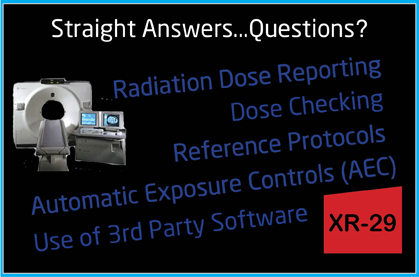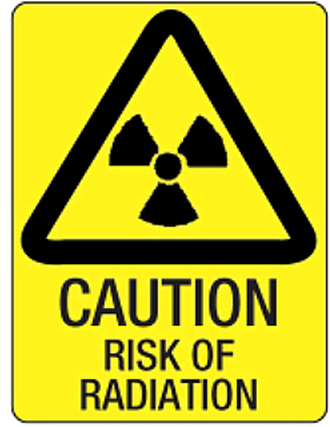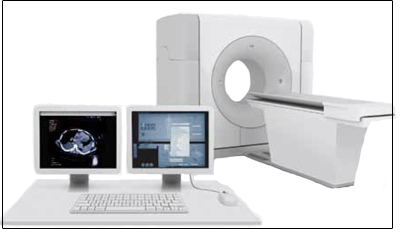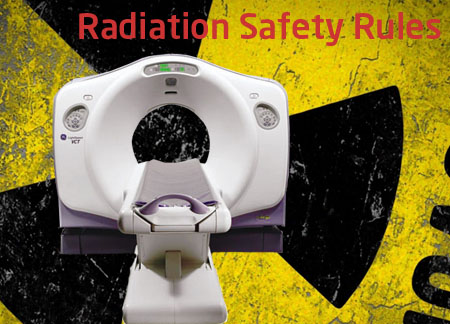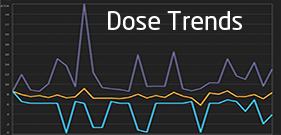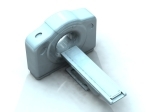Wanted: straight answers.
Creating standards. Improving reporting. Lowering dose to better the health and safety of patients and staff. These are laudable goals, and the new Standard XR-29-2013 from the National Electrical Manufacturers Association’s (NEMA’s) Medical Imaging & Technology Alliance (MITA) is taking them on.
Read More
Topics:
iterative image reconstruction,
Low-dose solution
A recent
study in the
Annals of Internal Medicine supports the value of low-dose CT lung scanning for high-risk Medicare-eligible patients. This is seemingly good news, right? MITA, the Medical Imaging and Technology Alliance, has come out and applauded the effort. And when taken at face value, it does seem praise worthy - groups are aligning and the benefit should be low dose
CT exams and improved health outcomes with both being achievable without a heavy financial burden for seniors.
Topics:
iterative image reconstruction,
Low-dose solution
Do you need more information on best practices to lower your CT dose? We have complied a list of informative articles to answer many questions you may have and explore options that can assist you today.
Read More
Topics:
iterative image reconstruction,
Low-dose solution,
More Than Just Imaging Solutions
How to be compliant with all upcoming standards without replacing your CT
The National Electrical Manufacturers Association’s Medical Imaging & Technology Alliance (MITA) has published XR 29 Standard Attributes on Computed Tomography (CT) Equipment Related to Dose Optimization and Management. XR 29, also known as MITA Smart Dose, includes four key features of CT equipment that enable optimization or management of radiation dose delivery while also providing high quality medical images.
Read More
Topics:
iterative image reconstruction,
Low-dose solution
Let me say at the outset that I am a Salesperson and I am proud of that. I have sold innovative, life-changing products into the diagnostic imaging market for over thirty years and it is a rewarding profession. I vividly remember the days of single slice CT scanning and providers increasing the dose on patients to get a more diagnostic image. It was routine practice when needed and not so much as a second thought was given in most circumstances about increased patient dose in order to improve diagnostic image quality. With the advent of helical scanning and multi-slice capabilities, the focus on CT dose in healthcare became a reality.
Read More
Topics:
iterative image reconstruction,
Low-dose solution,
CT Scanner
In
Radiology Today- Vol 14 No. 12, P10 written by David Yeager, there is an article entitled “Cloud-Based CT Dose Monitoring” published in December 2013. The article is important in the fact that more and more radiologists now have the opportunity to report on patient exposure to ionizing radiation from CT Scanners.
Topics:
Low-dose solution,
Medical Imaging News,
Imaging Equipment Solutions
Radiology departments are under pressure to track radiation dose from CT, and new rules are being proposed on both state and federal levels. A lot of our friends and customers were asking us questions about this at the recent RSNA convention. We decided to share some information, insights and answers through our new eBook, “Radiation Dose: Track, Monitor & Lower."
Read More
Topics:
iterative image reconstruction,
Low-dose solution,
Imaging Equipment Solutions
There are three distinct steps that we see CT providers taking to reduce patient radiation exposure on their CT scanners today. Lets take a look at these actions.
Read More
Topics:
iterative image reconstruction,
Low-dose solution,
CT Scanner
More so than ever, radiology departments are under pressure to track radiation dose from CT. Laws effective in some states, and the federal government proposing mandatory tracking in new Medicare rules for 2014, mean that institutional dose tracking will need to be as seamless as possible.
A team of radiologists at Stony Brook University in New York wanted to find the most simple and cost-effective way to monitor CT dose given what technology is available today. In doing so, they ended up developing a web-based service that does everything other solutions on the market do, just in a simpler fashion. They wrote about what they found, and what they have developed, in the September issue of the Journal of the American College of Radiology.
Read More
Topics:
Low-dose solution,
Medical Imaging News,
Imaging Equipment Solutions

